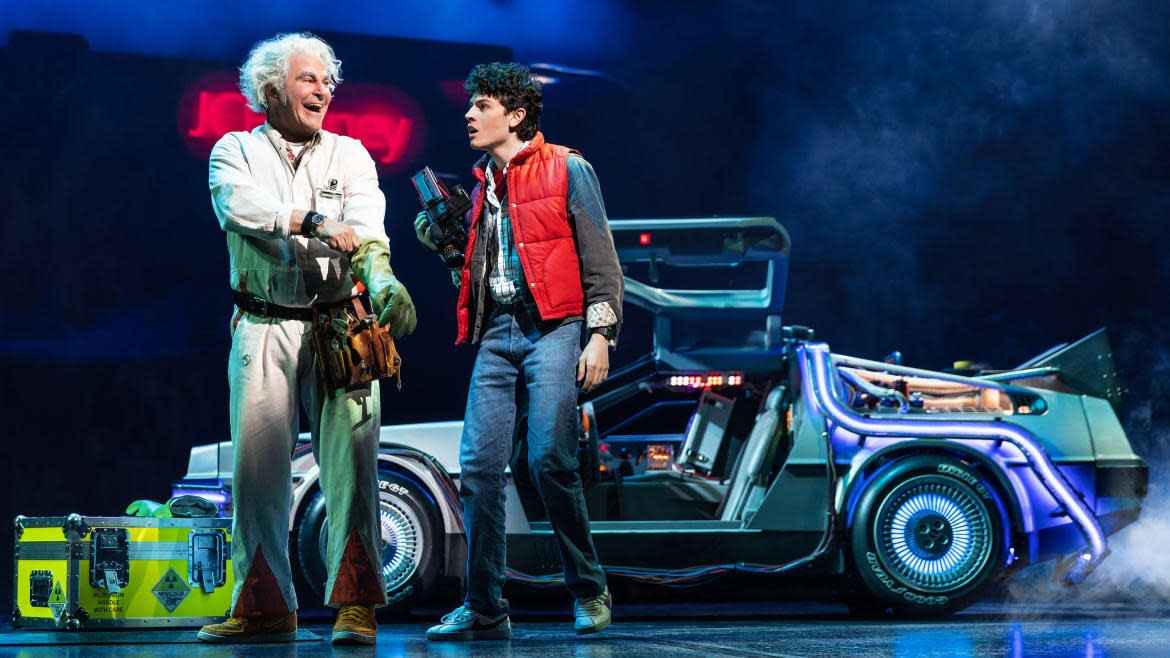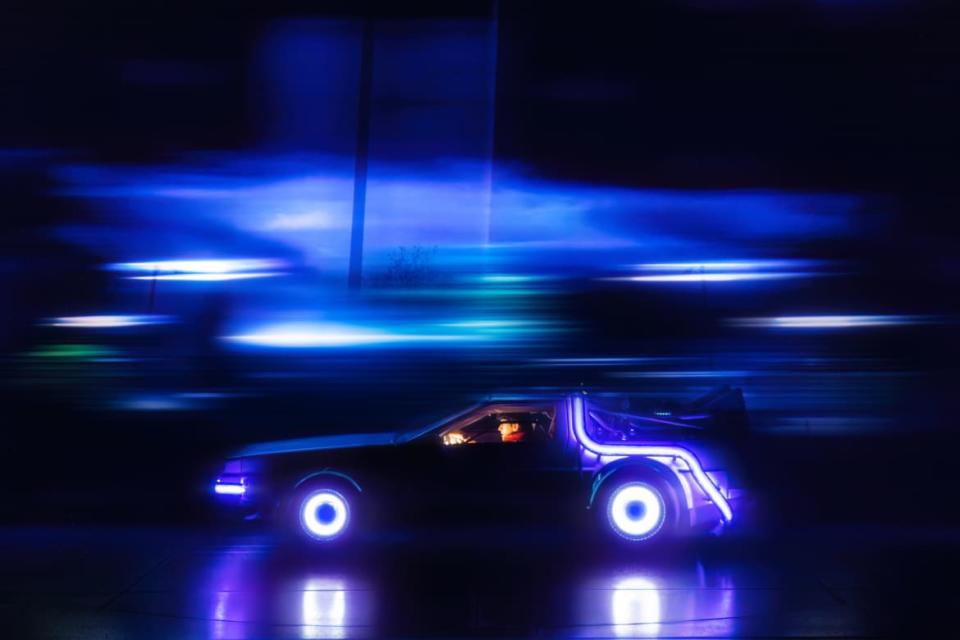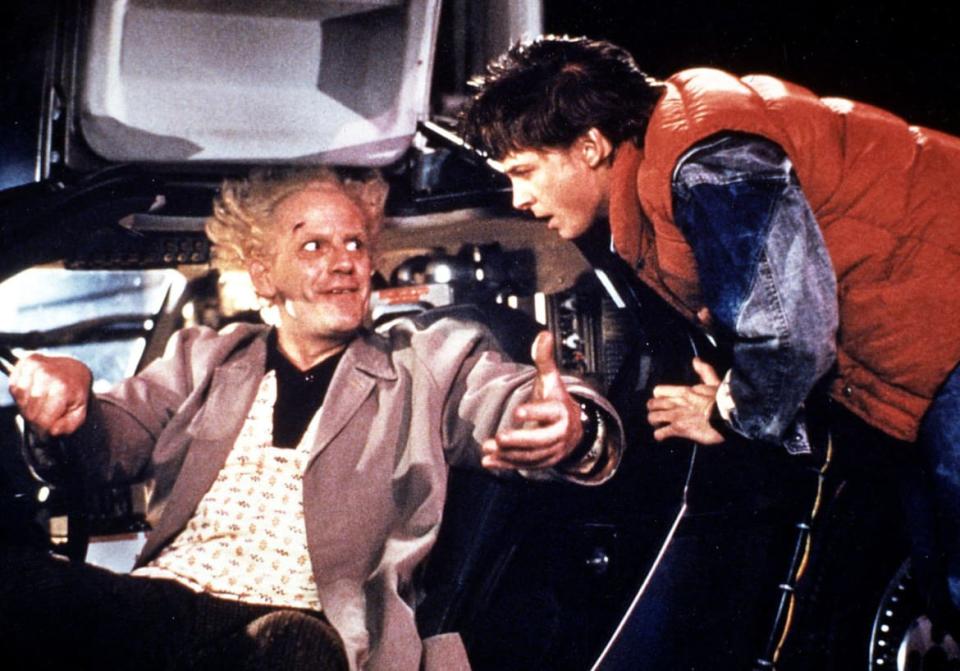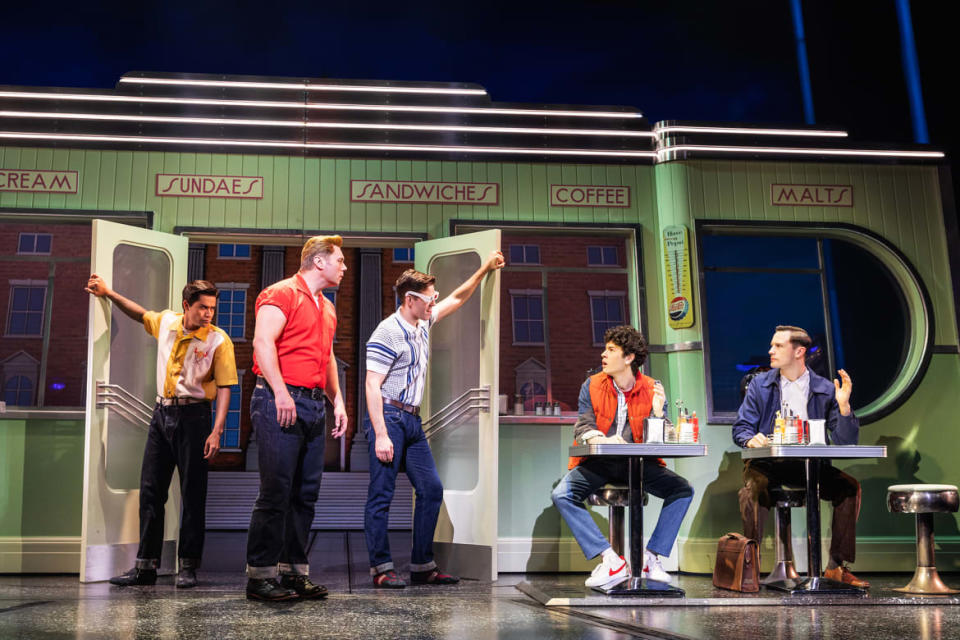Review: ‘Back to the Future: The Musical’ Is Perfect for the Movie’s Fans

- Oops!Something went wrong.Please try again later.
Sometimes a Broadway show just does what it needs to do, going big on songs, silliness, corn, and heart. And together those things work, even while some things frustratingly don’t work around them. The leviathan kicks into life, the audience jumps on and rides shotgun. Through the barrage of special effects, jokes, dramatic set-pieces, the stage-filling dancing and singing of the unsung heroes of the company—through all of it—the audience is visibly and audibly locked in, seduced, happy.
And so, sure, Back to the Future: The Musical—at two hours, 40 minutes, first staged in London’s West End—is overlong (almost an hour longer than the 1985 movie it is based on) and its female characters and its straining to say something about civil rights under-drawn and underdeveloped.
Review: ‘Shucked’ on Broadway Serves Up So Much Delicious Corn
But the show (Winter Garden Theatre, booking to Feb. 25, 2024) is also an amiably rollicking reanimation of a much-loved movie classic, and in no mood to address its flaws, which seem—ironically, given its preoccupation with time travel—stuck in another era.
The excellent Roger Bart as crazy-haired inventor Doc Brown led the cast in London and is single-handedly responsible for much of the show’s vim and playfulness, mugging to the audience, pacing and mis-pacing scenes, jigging and grinning, and enthusiastically mumbling all the sci-fi hokum the script throws at him. The show is a field of nostalgic Easter eggs for fans.
In a show that is too long, director John Rando brings a smart, witty lick to scenes and set-ups. The centerpiece of Tim Hatley’s design is, of course, the pimped-up, time-traveling DeLorean—and fans of the movie will not be disappointed by how the musical emulates the movie’s time-travel sequences and bombastic ending, and the car’s whooshing departure into the skies and space. The car is most definitely the star, even if for the most of the show it travels in rather limp circles.
Casey Likes, last seen in the glaringly lackluster Almost Famous, plays Marty McFly as yet another oddly displaced central character. We should care about him much more than we do. He sort of just bops around the stage, looking baffled and determinedly focused on the task at hand—having disrupted history by traveling back to 1955, he must ensure his parents kiss at their school dance, so they marry and he and his siblings are born. He is also a wannabe musician, who looks incredibly unsuited to electric guitars. His first song is, tellingly, a clunker: “I’ll rock my future/Could it be any cooler?/All I gotta do is play/My troubles disappear and go away.”

Casey Likes in the DeLorean time machine in 'Back to the Future: The Musical.'
This song is followed by his 1980s girlfriend, Jennifer (Mikaela Secada) singing a song reassuring Marty that he will be just fine. It is as if she has no inner life or real-life desires of her own; everything is in service of him: “And let me remind you/You’re everything to me/Something good is flowing/Wherever we’re going.” We don’t see Jennifer again until the very end when Marty has been returned to 1985, and she is still a moony, very definitely secondary partner in the relationship.
In a show all about hardware, what appositely dazzles is the lighting-streaked car, lighting (Tim Lutkin and Hugh Vanstone), sound (Gareth Owen), and video (Finn Ross); in stunning conjunction they all bring a flashing, whizz-bang magic to Back to the Future. One of the first effects—the DeLorean’s trip back through time to land in a rural ’50s hay barn—is a gasp-inducing visual (the show’s illusions are designed by Chris Fisher). The show brims with technical spectacle and mischief, even if the segues between individual scenes are bizarrely long and periodically deflate the pace.
Bob Gale’s book hews close to the movie (which Gale wrote with director Robert Zemeckis), with only a couple of significant departures from the original. There is no Einstein the dog, and there are no Libyan terrorists, meaning the show relies on plutonium poisoning as the thing that may kill Doc.
It does not deepen the story of Goldie Wilson (Jelani Remy, excellent), the Black restaurant sweeper (in 1955) who is town mayor in 1985. However, Goldie does wake the theater up from the stupor of its off-kilter opening; Alan Silvestri and Glen Ballard (music and lyrics) giving Goldie a rousing number that both hymns change, and personal responsibility when it comes to effecting change. Given the racism of the time, and how civil rights and other movements for change relied on collective engagement and collective expressions of anger and activism, the song seems resolutely stuck in the conservative, individualistic 1980s: “If you don’t respect yourself/Won’t get it from no one else…Do the best you can/Remain congenial/And someday you’ll be the man.”

Christopher Lloyd, left, and Michael J. Fox in 'Back to the Future,' the movie, 1985.
As well as Bart’s bizarre one-man-show mischief-making, Hugh Coles as Marty’s dad George is the show’s other standout performer. Coles performs a near-perfect impersonation-meets-simulation of the nervy, nerdy, wimp-turned-hero—nasally voice and all—that Crispin Glover originated in the movie. His bones and limbs move at impossible angles.
In the first iteration of 1985 at the start of the show, George is still the put-upon, bullied inadequate that Marty first meets in 1955. School bully Biff (a very good, thuggish Nathaniel Hackmann) is now his equally loathsome boss, and the nucleus of the show is about George finally standing up to Biff—and kissing would-be-wife Lorraine (Liana Hunt) on time. Just like Jennifer, Lorraine’s character is wanly underwritten; as in the film, the possibility of incest—her character in 1955 is attracted to Marty, her own son, who has traveled back in time—and it is a repeated joke that wears very thin.

(l to r) Daryl Tofa, Nathaniel Hackmann, Will Branner, Casey Likes, and Hugh Coles in "Back to the Future: The Musical."
Chris Bailey’s choreography, and the brilliant company of dancers—especially in the scenes when time is running out, or when Biff and his henchmen are out to get Marty—is consistently arresting, and the various payoffs of the show, while simple, are precisely executed. Marty’s actions not only result in his parents kissing, but in personality developments newly sourced in 1955 that radically changes the nature of the family life he returns to 30 years later.
A diehard fan of the movie came with me, and—just as the audience seemed around us—pronounced himself extremely happy. “It’s like candy for fans,” he said. True, a dopey smile was plastered on this more agnostic critic’s face throughout. Back to the Future is a night of winning froth—of striking visuals, a few very good performances, and perfectly fine songs—which, just as it emphatically resists examining its more complex contours, also does its dazzling best to ensure those watching do the same.
Get the Daily Beast's biggest scoops and scandals delivered right to your inbox. Sign up now.
Stay informed and gain unlimited access to the Daily Beast's unmatched reporting. Subscribe now.

